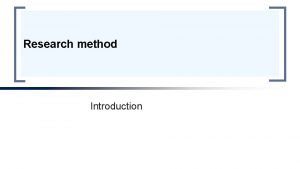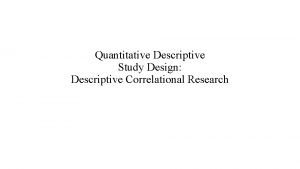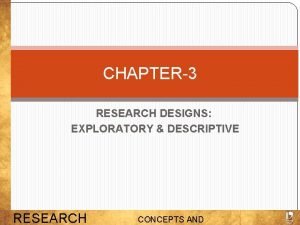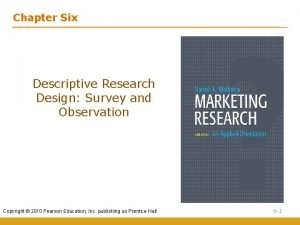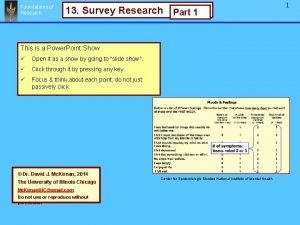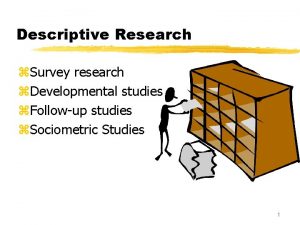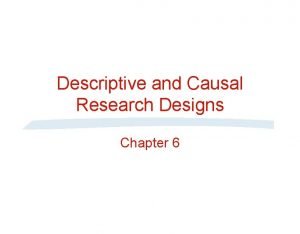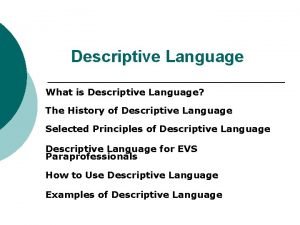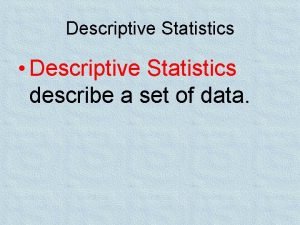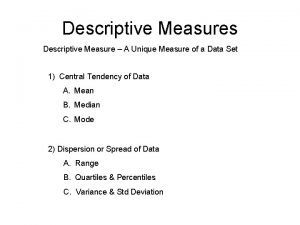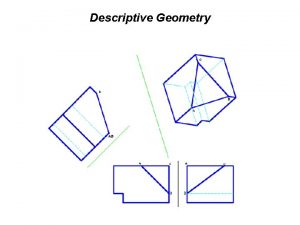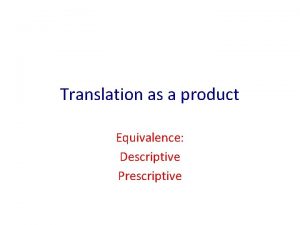DESCRIPTI VE DESCRIPTIVE RESEARCH AGENDA What is it


















































- Slides: 50

DESCRIPTI VE

DESCRIPTIVE RESEARCH AGENDA ▸ What is it? ▸ Advantages, Disadvantages ▸ Applicable Designs ▸ Data Collection Strategies ▸ Guidelines ▸ Sampling ▸ Bias

DESCRIPTIVE RESEARCH WHAT IS IT, WHAT CAN IT DO? ▸ A collection of research methods concerned with identifying the current state of the world how it is. ▸ Descriptive Research is used to: ▸ Describe the nature of observed phenomena ▸ Identify and describe relationships between observed phenomena

DESCRIPTIVE RESEARCH WHAT, EXACTLY? ▸ Observing ▸ Recording ▸ Describing (the clue is in the name) ▸ Classifying ▸ Contrasted with hypothesis-driven research

DESCRIPTIVE RESEARCH CHARACTERISTICS ▸ Almost always Quantitative Data ▸ Low control over the research context ▸ You study existing phenomena ▸ Data collection procedures must be highly explicit ▸ Non-Intervention

DESCRIPTIVE RESEARCH ADVANTAGES ▸ Data collection provides a lot of information useful to research and developing hypotheses ▸ Mostly quantitative, but if qualitative data exists, can provide holistic understanding ▸ Studies performed in “natural environment” so source of data is high-quality and honest ▸ Correlational Insights ▸ E. g. The Successful Project Manager

DESCRIPTIVE RESEARCH DISADVANTAGES ▸ Confidentiality - respondent’s aren’t always truthful ▸ Halo Effect - bias induced from research observer ▸ Sample isn’t Representative - may be hard to validate accurately represents whole ▸ Correlation Only ▸ No scope to learn cause - focus is on “what”, or “what relationship exists. ” ▸ We are not answering “why” or “how”

DESCRIPTIVE RESEARCH DESIGNS

DESCRIPTIVE RESEARCH DESIGNS ▸ We can only learn “what, ” not “why. ” ▸ Observational Studies ▸ Interviews ▸ Case Study ▸ Correlational Research ▸ Avoid the classic fallacy ▸ Developmental Designs - Progression over time ▸ Experience-Sampling Methods - Frequent/Ongoing ▸ Survey Research - Sample a group

DESCRIPTIVE RESEARCH QUESTION? ▸ After seeing these designs, do any of them look like they might fit your research?

DESCRIPTIVE RESEARCH DATA COLLECTION ▸ Non-Complex Variables ▸ Substantial Phenomena ▸ Intangible Phenomena ▸ Complex Variables (focus) ▸ Observations ▸ Interviews ▸ Questionnaires

DESCRIPTIVE RESEARCH - DATA COLLECTION TOOLS FOR THE QUANTIFICATION OF COMPLEX PHENOMENA ▸ Checklists ▸ List of items observed, present, or true (also opposite) ▸ Rating Scales ▸ Evaluate behaviors on a continuum (Likert) ▸ Rubrics ▸ Details assessing performance

DESCRIPTIVE RESEARCH - DATA COLLECTION TOOLS CHECKLISTS ▸ Simplify/Quantify ▸ Examples ▸ Chimpanzee Research by Jane Goodall ▸ “On the Origin of Species” - Charles Darwin ▸ “The Beak of the Finch” - Jonathan Weiner ▸ “A Brief History of Time” - Stephen Hawking

DESCRIPTIVE RESEARCH - DATA COLLECTION TOOLS - RATING SCALES ▸ Typical Scales: ▸ Inadequate -> Excellent ▸ Never -> Always ▸ Strongly Disapprove -> Strongly Approve ▸ Simplifies and Quantifies, Efficiently ▸ Qualitative “Why” is lost ▸ Yields Ordinal Data, not Interval

DESCRIPTIVE RESEARCH - DATA COLLECTION TOOLS - RUBRICS ‣ Concrete descriptions for levels of performance

DESCRIPTIVE RESEARCH - DATA COLLECTION TOOLS - RUBRIC EXAMPLE ▸ Evaluate Student Writing Skills ▸ Scale: 5 -Proficient, 3 -In Progress, 1 -Developing ▸ Measure: Spelling, Punctuation, Complete Sentences, Focus, Logical Thought, Convincing Argument ▸ Student 1: 5, 5, 5, 1, 1, 1 -> total: 18 ▸ Student 2: 1, 1, 1, 5, 5, 5 -> total: 18 ▸ Completely different papers and outcomes - same score ▸ Conclusion: Numbers in ordinal data don’t mean the same as interval

DESCRIPTIVE RESEARCH OTHER TOOLS IN MODERN PRACTICE ▸ Tools have grown more powerful today ▸ X-ray Diffraction ▸ Used to study chemical makeup of minerals and describe the structure of DNA ▸ Mass Spectrometers ▸ Determine absolute age instead of relative age ▸ GPS accurately pinpoints sample locations ▸ MRI allows examination of organs inside living bodies

DESCRIPTIVE RESEARCH - DATA COLLECTION OTHER RESEARCH TOOLS ▸ Interviews ▸ Questionnaires ▸ Requires pre-planning to be successful

PLANNING AND CONDUCTING INTERVIEWS

DESCRIPTIVE RESEARCH - DATA COLLECTION INTERVIEW FOR QUANTITATIVE STUDY GUIDELINES ▸ Limit questions to answer research question ▸ Revise questions based on quantifying the response ▸ Restrict each question to a single idea ▸ Include a few open-ended, qualitative questions ▸ Use technology to streamline the process ▸ Pilot test

DESCRIPTIVE RESEARCH - DATA COLLECTION CONDUCTING THE INTERVIEW ▸ Introduce Yourself and Explain Purpose ▸ Informed Consent ▸ Get permission in writing ▸ Save controversial questions for later in the interview ▸ Seek clarifying information when necessary

DESCRIPTIVE RESEARCH - DATA COLLECTION QUESTIONNAIRES GUIDELINES ▸ Keep it Short ▸ Respondent task simple and concrete ▸ Straightforward, Simple instruction ▸ Simple, clear language ▸ Provide rationale for unclear purpose ▸ Check for unwanted assumptions in your questions - Leading Questions

DESCRIPTIVE RESEARCH - DATA COLLECTION QUESTIONNAIRES - UNWANTED ASSUMPTIONS EXAMPLE ▸ How many cigarettes do you smoke a day? ▸ More than 25 ▸ 25 -16 ▸ 15 -11 ▸ 10 -6 ▸ 5 -1 ▸ None

TEXT QUESTIONNAIRES - GUIDELINES CONCLUDED ▸ Don’t give clues about preferences/more desirable answers ▸ “What strategies have you used to try and quit smoking? ” ▸ Check for consistency ▸ Make it attractive and professional looking

TEXT USING TECH TO HELP WITH QUESTIONNAIRES ▸ Responding on laptop or tablet ▸ For distant participants - use email ▸ Use paper mail delivery to personalize correspondence ▸ Be sure to use a SASE ▸ Offer results of study ▸ Be gently persistent ▸ Use the Internet —> Survey. Monkey

COMMON SOURCES OF BIAS

DESCRIPTIVE RESEARCH BIAS ▸ Sampling ▸ Instrumentation ▸ Response ▸ Researcher

DESCRIPTIVE RESEARCH IDENTIFYING POSSIBLE SAMPLING BIAS ▸ Scrutinize items that influence respondents vs. non-respondents ▸ Some may be more interested in the topic than others ▸ Compare responses returned quickly against later responses ▸ Later ones - typical non-responder ▸ Randomly select a small number of non-responders and contact them ▸ Are responses to questions similar to those of respondents?

DESCRIPTIVE RESEARCH DESCRIPTIVE IN ▸RESEARCH Charles King Survey PRACTICE ▸ Exploring the US West (1860 -1879) ▸ Study 40 th parallel

DESCRIPTIVE RESEARCH WHEELER SURVEY ▸ George Montague Wheeler Map west of 100 th meridian ▸ scale: 8 miles to an inch ▸ Photos: Library of Congress: Survey views of the American West (18711874)

DESCRIPTIVE RESEARCH GEOLOGICAL SURVEY OF 1871 ▸ Ferdinand Vandeveer Hayden ▸ 1870: received a $25, 000 governmental grant to lead a 20 man expedition to South Pass, Fort Bridger, Henry's Fork, and back to Cheyenne.

DESCRIPTIVE RESEARCH POWELL EXPEDITIONS ▸ John Wesley Powell ▸ Colorado River and Grand Canyon (1867 - 1869) ▸ Assistant Gilbert made drawings ▸ Studied by others in 1988, 1995

DESCRIPTIVE RESEARCH SUMMARY ▸ Described Descriptive Research ▸ Applicable Designs for Research ▸ Data Collection Strategies ▸ Guidelines ▸ Sampling ▸ Bias ▸ Examples

MIXED-METHODS RESEARCH

MIXED-METHODS RESEARCH AGENDA ➢ Mixed Methods Design. ➢ Types of Designs. ➢ Planning for mixed methods research. ➢ Approaches to analyzing data.

MIXED-METHODS RESEARCH WHAT IS IT? ➢Research problems requiring quantitative and qualitative dimensions. ➢Requires ▪ Collecting ▪ Analyzing ▪ Interpreting both quantitative and qualitative data. ▪ And Integrating conclusions from both. ➢Challenging.

MIXED-METHODS RESEARCH - DESCRIPTION USEFUL WHEN? ➢Completeness: Ability to address a problem and its sub-problems. ➢Complementarity: Compensate weakness of one aspect. ➢Hypothesis generation and testing: Provides insights. ➢Development of appropriate research tools and strategies: Guide subsequent steps ➢Resolution of puzzling findings: Making sense of inconsistent findings. ➢Triangulation: Strengthen findings.

MIXED-METHODS RESEARCH - DESCRIPTION COMMON MIXED METHOD DESIGNS 1. Convergent Designs. 2. Embedded Designs. 3. Exploratory Designs. 4. Explanatory Designs. 5. Multiphase iterative Designs.

MIXED-METHODS RESEARCH - DESIGNS CONVERGENT DESIGNS ➢Collect both qualitative and quantitative data in parallel. ➢At the same time. ➢Equal weight to the two types of data. ➢Hopes analysis leads to similar conclusions.

MIXED-METHODS RESEARCH - DESIGNS EMBEDDED DESIGNS ➢Collects both qualitative and quantitative data in parallel. ➢One approach dominates. ➢Ex: Survey of people’s opinion on a topic.

MIXED-METHODS RESEARCH - DESIGNS EXPLORATORY DESIGNS ➢Phase 1: ▪ Qualitative methods to explore characteristics / phenomena. ▪ Form hypothesis. ➢Phase 2: ▪ Quantitative study to test those hypothesis.

MIXED-METHODS RESEARCH - DESIGNS EXPLANATORY DESIGNS ➢Phase 1: ▪ Collecting quantitative data using experiments, surveys etc. ▪ Data analysis yields statistics. ➢Phase 2: ▪ Follow up qualitative study to describe phase-1 answers.

MIXED-METHODS RESEARCH - DESIGNS MULTIPHASE ITERATIVE DESIGNS ➢Include three or more phases. ➢Iterative Design, moving back and forth b/w qualitative & quantitative. ➢Ex: Effectiveness of a program to reduce drug abuse in teenager

MIXED-METHODS RESEARCH - DESIGNS NOTATIONS Designs Convergent Designs Notation QUAL+QUAN Embedded Designs QUAL(quan), QUAN(qual) Exploratory Designs QUAL -> QUAN Explanatory Designs QUAN -> QUAL Multiphase Designs QUAL->QUAN->QUAL

MIXED METHODS RESEARCH IDENTIFYING MIXED-METHODS RESEARCH DESIGN “A researcher conducts in-depth case studies of two average-intelligence middle school boys who have dyslexia. In the case studies, the researcher especially focuses on (a) the challenges and frustrations the boys face in their daily academic work and (b) strategies they have developed to help them cope with these challenges and frustrations. The researcher then uses the case study data to develop checklist questions for interviews to be conducted with a sample of 45 middle school students with dyslexia. ” ? ?

MIXED METHODS RESEARCH IDENTIFYING MIXED-METHODS RESEARCH DESIGN “A researcher conducts in-depth case studies of two average-intelligence middle school boys who have dyslexia. In the case studies, the researcher especially focuses on (a) the challenges and frustrations the boys face in their daily academic work and (b) strategies they have developed to help them cope with these challenges and frustrations. The researcher then uses the case study data to develop checklist questions for interviews to be conducted with a sample of 45 middle school students with dyslexia. ” Exploratory design, QUAL->QUAN

MIXED METHODS RESEARCH PLANNING A MIXED-METHODS STUDY 1. Identifying Research Questions and Hypotheses. 2. Conducting the Literature Review. 3. Choosing One or More Appropriate Samples. 4. Addressing Validity Concerns. 5. Special Ethical Considerations in Mixed-Methods Research.

MIXED-METHODS RESEARCH ANALYZING AND INTERPRETING MIXEDMETHODS DATA 1. Condensing the data. 2. Depicting general patterns in the data in ways that enable quick visual inspection. 3. Transforming qualitative data into quantitative entities (an optional step). 4. Systematically comparing and integrating results from the two types of data.

MIXED-METHODS RESEARCH CONCERNS

MIXED-METHODS RESEARCH QUESTIONS?
 Agenda sistemica y agenda institucional
Agenda sistemica y agenda institucional Research agenda example
Research agenda example D.o. 39 s. 2016
D.o. 39 s. 2016 Research problem statement and objectives examples
Research problem statement and objectives examples Advantages of descriptive research
Advantages of descriptive research Nature marketing research
Nature marketing research Advantages and disadvantages of parallel study design
Advantages and disadvantages of parallel study design Descriptive research question
Descriptive research question Symbolic representation in research
Symbolic representation in research Descriptive research design
Descriptive research design Cross-sectional correlational design
Cross-sectional correlational design Descriptive correlational research design example
Descriptive correlational research design example Exploratory research vs conclusive research
Exploratory research vs conclusive research Descriptive research design
Descriptive research design Examples of descriptive research
Examples of descriptive research Descriptive and causal research
Descriptive and causal research Purpose of descriptive research
Purpose of descriptive research Descriptive research design
Descriptive research design Descriptive research design
Descriptive research design Descriptive vs correlational vs experimental research
Descriptive vs correlational vs experimental research How is descriptive research conducted
How is descriptive research conducted Descriptive method research
Descriptive method research Strengths and weaknesses of correlational research
Strengths and weaknesses of correlational research Research design formulation
Research design formulation Whats descriptive research
Whats descriptive research Descriptive study example
Descriptive study example Descriptive research design
Descriptive research design Business research design meaning
Business research design meaning Descriptive research
Descriptive research Qualitative hypothesis example
Qualitative hypothesis example Dog statement of convention example
Dog statement of convention example Sociometric test questionnaire
Sociometric test questionnaire Confirmatory research
Confirmatory research Descriptive and causal inference
Descriptive and causal inference Research report vs research proposal
Research report vs research proposal Research design vs research method
Research design vs research method Research appendix sample
Research appendix sample The difference between basic research and applied research
The difference between basic research and applied research Qualitative research
Qualitative research Contrast applied research and basic research
Contrast applied research and basic research Research problem and research objectives
Research problem and research objectives Research paradigm example
Research paradigm example Operational thought
Operational thought Examples of causal comparative research
Examples of causal comparative research Chapter 3: research methodology
Chapter 3: research methodology Example of applied research
Example of applied research Basic research vs applied research
Basic research vs applied research Purpose of research
Purpose of research Qualitative research methods
Qualitative research methods What is inquiry in practical research 2
What is inquiry in practical research 2 Research objectives examples
Research objectives examples







